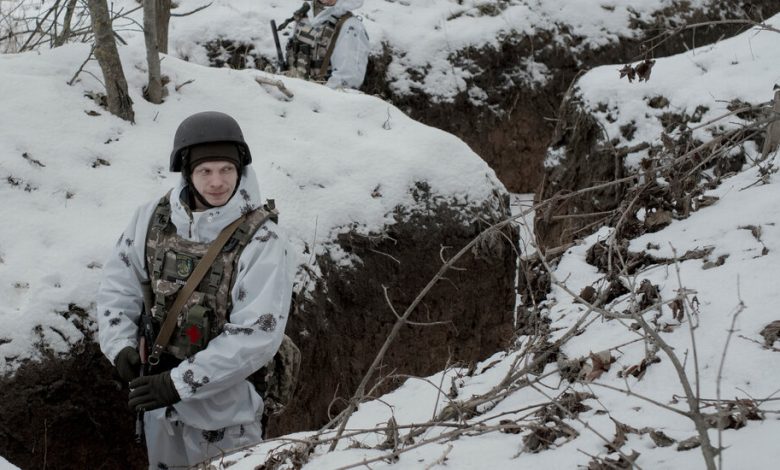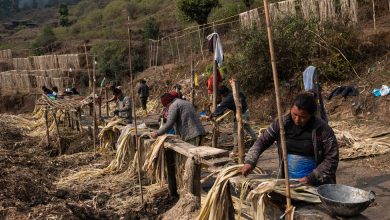In Northern Ukraine, a Different Sort of War Game

SLAVHOROD, Ukraine — Out in the snowy fields and birch and oak forests along the far northeastern border with Russia, the war on the Ukrainian side is mostly one of watching and listening.
Working in shifts in the town of Slavhorod, just a mile or two from the border with Russia, Ukrainian soldiers were recently peering through a powerful set of field binoculars at their counterparts milling about a position on the Russian side. From time to time, Russian attack helicopters buzzed about, as artillery fire boomed from the Russian side, as it does nearly every day.
But none of that was cause for concern for the Ukrainian soldiers, even as officials in Kyiv and military analysts have issued a stream of warnings about an imminent Russian offensive, possibly around the first anniversary of Russia’s invasion on Friday.
“We cannot say they are preparing for something. They don’t have heavy weapons to attack,” said Col. Roman Tkach, a border guard officer. “Most likely, they are shooting to keep our forces stretched along the border.”
The fiercest battles in Ukraine are raging elsewhere along a 600-mile crescent from south to east within Ukraine’s borders. If a major Russian counteroffensive does eventually materialize, analysts say it is most likely to occur farther south, in the Donbas region and around Zaporizhzhia.
A different war game seems to be playing out in the Sumy region along the far northern border areas, where cross-border shelling has been occurring for months.
Armies typically fire artillery bombardments to soften defenses for ground assaults. But in northern Ukraine, Russia has fired away at civilian and military targets without any follow-up, apparently with the aim of tying up tens of thousands of Ukrainian soldiers far from the more decisive battles in southeastern Ukraine, analysts say.
Indeed, along the northern border, the Ukrainian military has dug mazes of fresh trenches. Armored vehicles rumble along the roads, and soldiers fan out to staff the fortified positions, all this activity done to prepare for an offensive that might not come anytime soon.
At the Ukrainian position near Slavhorod, the soldiers look out over the golden stubble of a harvested wheat field dusted with recent snows, receding into gently rolling farm fields and a reedy swamp, from which flocks of robins flutter up whenever a car passes.
The State of the War
- Biden Visits Kyiv: President Biden traveled covertly to the besieged Ukrainian capital, hoping to demonstrate American resolve and boost shellshocked Ukrainians. But the trip was also the first of several direct challenges to President Vladimir V. Putin of Russia.
- Portending a Global Rift: Secretary of State Antony J. Blinken said that China is strongly considering giving military aid to Russia, a move that would transform the war into a struggle involving three superpowers.
- A Russian Mole in Germany?: A director at Germany’s spy service was arrested on suspicion of passing intelligence to Russia. German officials and allies worry just how deep the problem goes.
A Russian position stands only a mile or two away, visible through the field binoculars, with Slavhorod lying in between. Although the Ukrainian soldiers can clearly see the Russian infantry position across the valley in Russia, they do not fire artillery at it. Their infantry position, in contrast, is regularly shelled.
That is because the Ukrainian government permits its forces only to return fire at Russian artillery, not strike preemptively at Russian infantry positions. And they have to use their Soviet-era weaponry, not the more powerful and accurate howitzers or guided rockets provided by the United States and other allies, who fear attacks on Russian territory with Western weaponry could escalate the war into direct conflict between Russia and NATO.
That limitation is a source of considerable frustration for the Ukrainians all along the front.
“It’s one thing for an army to fight an army, another thing when they fight civilians,” said Lieutenant Kostyantyn, who was commanding a position to the south in Ukraine’s Kharkiv region. He and other soldiers asked to be identified only by first name and rank, for security reasons. “I want to tear Russians apart with my bare hands.”
When Russia invaded Ukraine on Feb. 24 last year, border guards were ordered to pull back from Slavhorod and most points at or near the border, said a Ukrainian commander, Colonel Serhiy.
A hidden camera that Colonel Serhiy set up in Slavhorod captured Russian tanks and armored personnel carriers rumbling in just after dawn, he said. Then they rumbled back the other way, having taken a wrong turn. That typified the Russian assault, Colonel Serhiy said. Bogged down after a month of punishing ambushes, the Russians eventually retreated.
Safely across the border, the Russian army began shooting back into Ukraine in barrages that have become more intense in recent months. “Every day since, the border regions are shelled,” Colonel Serhiy said.
Russia has fired rocket artillery and incendiary shells that burst in the air above the ground, sending down a brilliant, white rain of burning phosphorous and other chemicals, sent jets and attack helicopters on sorties and deployed sabotage units to slip across the border and plant land mines.
A Ukrainian military report of shelling on Wednesday, for example, cited artillery strikes on dozens of villages, all along the border. “We file reports like that every day,” Colonel Serhiy said.
If Russia were to alter its strategy and once again try to sweep through the north, the Ukrainians would be ready, Gen. Viktor Nazarov, an adviser to the commanding general in Ukraine’s army, Gen. Valeriy Zaluzhny, said in an interview.
In that event, General Nazarov said, Ukraine would respond with artillery and ground assaults on supply lines, ammunition depots and command points, and combat would swirl 30 or so miles into the Russian regions of Belgorod, Kursk and Bryansk.
“It will mean war will take place on the territory of the Russian Federation,” General Nazarov said. “It is not a red line we are afraid of crossing. They have fear themselves, because it would influence the population living there. The impression will be that the situation is not controlled, that the war has come to their own homes.”
For now, as the war drags on, Russian artillery is firing into border villages like Slavhorod, a jumble of wood and brick homes, corrals for livestock, and apple orchards. About a quarter of its 224 houses have been damaged, said its mayor, Ina Kononenko, with one bombardment in October destroying the health clinic, school and cultural center. To date, only one resident has died in the shelling, the soldiers said.
But the residents live in constant fear. “We live on a box of gunpowder that could explode at any moment,” Ms. Kononenko said. “What can I tell you, yes, they fire artillery at us sometimes,” she said. “We were all very afraid. They shoot at us for no reason.”
For Svitlana Hlyanko, 41, the barrage that destroyed her house began with deafening explosions.
She huddled in a corner of a room with her three children, she said, and when it was over, she walked out to find gaping craters in a field a dozen yards away. She and the children were unharmed, but the shells had sprayed the house with shrapnel and shattered all the windows, rendering it uninhabitable.
In the town of Vovchansk about 90 miles from Slavhorod and a mile or two from the Russian border, shells whistle in nearly every day. Of a prewar population of 17,000, about 4,000 remain.
“Russia fires randomly into the town but aims precisely at infrastructure,” such as the central heating plant and electrical substations, said the mayor, Tamaz Hambarashvily.
Left without electricity or heat from the shelling, residents get by with wood stoves and kerosene lamps.
“I wish they would not shell the power lines,” said Nadia, a 73-year-old retiree, who asked that only her first name be used for safety, lest Russia reoccupy her town. “When we have electricity, we are alive. With no electricity, we will freeze like field mice.”
Olha Kostashenko, 47, lives with her husband in Vovchansk, spending much of her time underground for safety, showing the toll of the shelling on people living along the border.
“I organized a little room for myself in the basement and mainly stay here and cry each time there is a shelling,” she said. “Here in the basement, I have candles, a power bank, a flashlight, a little electric heater and I knit socks, just to do something and not go mad.”




